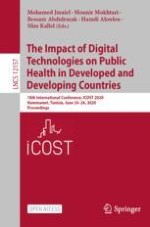Open Access 2020 | Open Access | Buch

The Impact of Digital Technologies on Public Health in Developed and Developing Countries
18th International Conference, ICOST 2020, Hammamet, Tunisia, June 24–26, 2020, Proceedings
herausgegeben von: Prof. Mohamed Jmaiel, Mounir Mokhtari, Prof. Bessam Abdulrazak, Hamdi Aloulou, Slim Kallel
Verlag: Springer International Publishing
Buchreihe : Lecture Notes in Computer Science